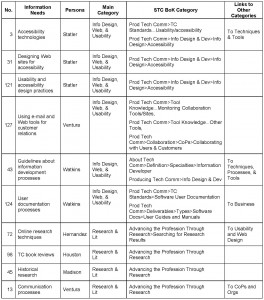Purpose of the Persona Matrix
The Persona Matrix is a tool for comparing the information needs of various users of the Technical Communication Body of Knowledge (TCBOK). The personas that the Society for Technical Communication (STC) developed represent the types of users who will be searching the TCBOK for information that interests them. This article describes how content creators can use the Persona Matrix to help build and place content for the TCBOK wiki.
Using the Persona Matrix to Shape and Place Wiki Content
Content creators and wiki content managers can use the Persona Matrix to inform decisions about what content to include to best satisfy the personas’ information needs, where to put articles, and how to link to other articles in related categories. The Persona Matrix contains columns for the information needs of all of the personas, the personas’ names, a set of main categories developed through card sorting, equivalent TCBOK categories, and suggested links to other categories (Figure 1).

Figure 1: Example Page from Persona Matrix
How the Matrix Was Developed
The information needs of all personas were extracted from the persona descriptions and condensed into single words or short phrases. Each information need was printed on a sorting card for sorting into groups. The objectives of this card sorting exercise were to:
- Analyze personas’ shared information needs
- Compare the categories that emerged from the sorting with the existing TCBOK categories
- Develop category clusters that reflect shared information needs
- Use category clusters to develop a visual schema representing the larger architecture of a knowledge portal (see Information Architecture of the BOK Project).
During the card sorting, related information needs were clustered into the following groups:
- Academic & Training Programs
- Business Processes & Organizational Issues
- Career Roles & Specialties
- Communities of Practice (CoPs) and Professional Organizations
- Research & Literature
- Techniques, Processes, & Tools
- Information Design, Web, & Usability
- Content Management
- Translation, Localization, & Globalization
These groups are referred to as Main Categories. In the Persona Matrix, there is a row for each information need with corresponding columns containing the persona’s name, the main category, and the TCBOK category.
In contrast, the TCBOK wiki portal is organized into four main sections:
- About technical communication
- Managing your career in technical communication
- Producing technical communication
- Advancing the profession through research
Each of these TCBOK sections has extensive subcategories. For each information need, the Persona Matrix allows comparison of the TCBOK categories with the clustered categories developed during the card sorting. The clustered categories allow one to see where personas share similar interests. For example, the “Information Design, Web, and Usability” cluster contains three major categories that are related, so a content creator can use the Persona Matrix to see where related information might be referenced in the TCBOK information hierarchy.
How to Use the Matrix
To aid content creators in shaping articles and deciding where to put them on the TCBOK wiki, the matrix can be sorted by:
- Main Category
- Persona
- Information Needs
Wiki article writers can sort the table by the Persona column to see which categories a persona’s information needs fall into, and by the Main Category column to see which Personas share interests. This may help authors in organizing articles so they link to related information and in assessing how well an article meets personas’ needs. Content managers can use the matrix to decide where to place articles in the TCBOK by sorting on the TCBOK Category column. Developers of the TCBOK may want to perform additional card-sorting exercises for perspective on the navigation design of the ultimate interface for the TCBOK.
Credits
Dan Portwood.
